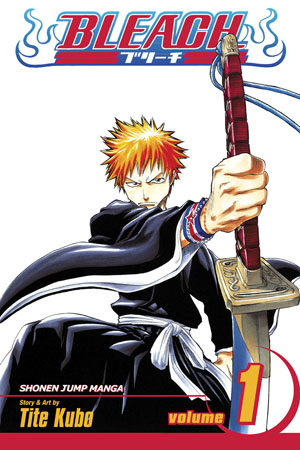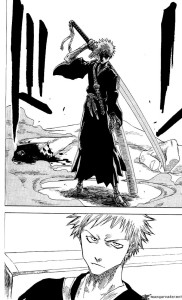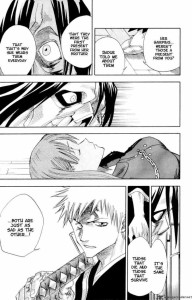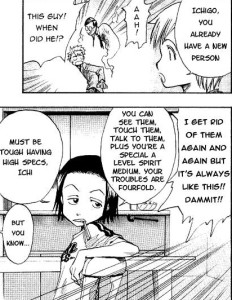Contemporary Fantasy Manga 101: Bleach
Glenn Hough (gallyangel) is a nonpracticing futurist, an anime and manga otaku, and is almost obsessive about finishing several of the lists tracked on WWEnd. In this series on Fantasy Manga Glenn will provide an overview of the medium and the place of fantasy within it.
 To say that Bleach is a popular Manga here, in Japan, and around the world is to understate the obvious. Bleach is a Pop cultural icon of the worldwide manga movement.
To say that Bleach is a popular Manga here, in Japan, and around the world is to understate the obvious. Bleach is a Pop cultural icon of the worldwide manga movement.
Tite Kubo, as a mangaka, is prolific. Bleach debuted in August of 2001. As of this writing, chapter 573 is due out this week. That’s about 63 takubon worth of material. That’s quite the pace for a weekly series since I’m sure he did have some time off during the last ten plus years. Bleach has probably made Kubo a Billionaire many times over. (A billion Yen. The quick and dirty conversion for Yen to Dollars is to move the decimal two places to the left so ¥1,000,000,000 equals $10,000,000. One Yen is like one Cent.)
This is what VIZ says about Bleach, Vol. 1:
Strawberry and the Soul Reapers
Ichigo Kurosaki has always been able to see ghosts, but this ability doesn’t change his life nearly as much as his close encounter with Rukia Kuchiki, a Soul Reaper and member of the mysterious Soul Society. While fighting a Hollow, an evil spirit that preys on humans who display psychic energy, Rukia attempts to lend Ichigo some of her powers so that he can save his family; but much to her surprise, Ichigo absorbs every last drop of her energy. Now a full-fledged Soul Reaper himself, Ichigo quickly learns that the world he inhabits is one full of dangerous spirits and, along with Rukia–who is slowly regaining her powers–it’s Ichigo’s job to protect the innocent from Hollows and help the spirits themselves find peace.
One can easily dismiss Bleach as being just a fight manga, no more complicated than a video game wherein Ichigo levels up fight after fight, working his way up the bad guy (Hollow) food chain, so he can fight the boss monster at the end of the level. And surprise, surprise, another level always opens up afterwards. That’s kinda what it does look like; it’s kinda the truth. But if that’s all you think is there, then you do miss the point.
It all seems perfectly true, except Miyamoto Mushashi did the exact same thing in his lifetime.
If you don’t know, Miyamoto Mushashi is probably the best known example of the Japanese swordsman and ronin in all of Japan’s long and very bloody history of the samurai culture. Mushashi is the pinnacle. (Vagabond, published by VIZ, is an historical manga based on the life of Mushashi. That monster, 35 takubon and still going, is one hell of a read! Highly recommended.) Mushashi’s early life is basically an exposé of the swordsman culture: he goes from village to village, city to city, to fight, to test himself against stronger and stronger opponents, learning everything there is to know about the way of the sword in the process.
 Mushashi is the supreme example of what the Japanese would call “becoming invincible under the sun”. Ichigo is also an example of this. Ichigo is actually following along a well worn cultural and spiritual pathway, so to ignore Ichigo and Bleach is to ignore a central pillar of how the Japanese see themselves. Yes, it’s told through the lens of pop culture and manga, but this is the myth of the Japanese narrative at work. This is how Japan should be in the eyes of Kubo. It is the longing of the warrior to become invincible under the sun.
Mushashi is the supreme example of what the Japanese would call “becoming invincible under the sun”. Ichigo is also an example of this. Ichigo is actually following along a well worn cultural and spiritual pathway, so to ignore Ichigo and Bleach is to ignore a central pillar of how the Japanese see themselves. Yes, it’s told through the lens of pop culture and manga, but this is the myth of the Japanese narrative at work. This is how Japan should be in the eyes of Kubo. It is the longing of the warrior to become invincible under the sun.
Mushashi’s desire was self-centered: to be invincible under the sun is to stand alone. Ichigo’s desire is the polar opposite: to gain greater and greater ability to protect those he cares for is true invincibility. And one of the keys is always standing with one’s friends. Ichigo’s first trial was to protect his family from Hollows. Then it was to protect Rukia from the Injustice of Soul Society, before moving on to save Soul Society itself from a being who would become a God, and use all of Soul Society as a stepping stone to that end.
 Bleach is a morality play just as surely as any Arthurian tale ever was. It functions the same way: through entertainment and enlightenment by example. Ichigo shows us the warrior code of Japan. This is how a hero acts — this is who a hero is. Ichigo is on the same quest of the great Mushashi. He’s just doing it in the mind and on the page and not in what we quaintly call the real world.
Bleach is a morality play just as surely as any Arthurian tale ever was. It functions the same way: through entertainment and enlightenment by example. Ichigo shows us the warrior code of Japan. This is how a hero acts — this is who a hero is. Ichigo is on the same quest of the great Mushashi. He’s just doing it in the mind and on the page and not in what we quaintly call the real world.
And yet, it’s just a fight manga. Everyone has a sword. All the swords have cool names and even cooler powers: Senbonzakura (One Thousand Cherry Blossoms), Sode no Shirayuki (Sleeve of White Snow), Benihime (Crimson Princess), or Ichigo’s Zangetsu (Cutting Moon). Everyone can use attack Kudo (attack magic/spiritual energy) if they know how. And there is no limit to how bad the villains can get. Ichigo has no trouble finding new adventures for himself and his friends. Of which, there are a lot. By this time in the manga, 573 chapters in, Bleach‘s population of named and known characters is over a 100. It’s a big complicated universe of people Ichigo lives and fights side-by-side with. For that seems to be the central message: no matter how powerful Ichigo gets, his faith in the shared bonds of friendship he has forged, always tips the scales of battle in his favor. With a little help from his friends, Ichigo is invincible under the sun.
Finding Bleach is no problem at all. Our friends at VIZ keep it in print, both on paper and digital format, since there is a very hungry market of otaku following this title. A free copy, concurrent with the Japanese release schedule, can be had at mangapanda.com. Bleech is also available on Amazon.



















 Full Details
Full Details




No comments yet.
Sorry, the comment form is closed at this time.